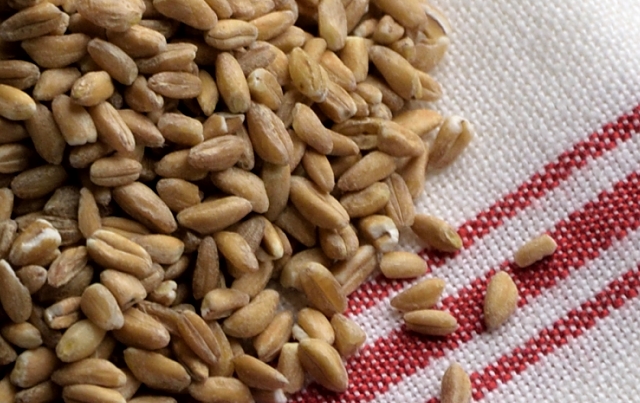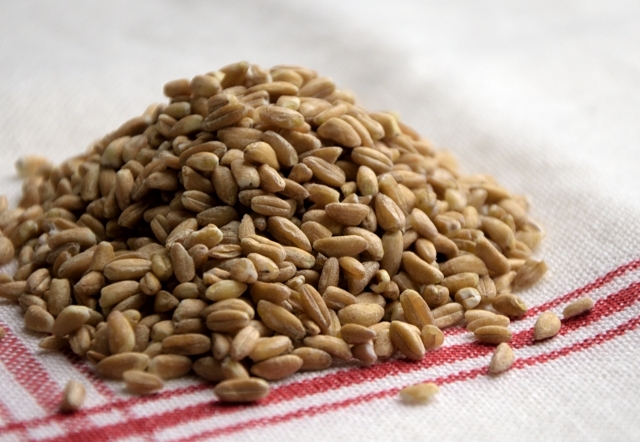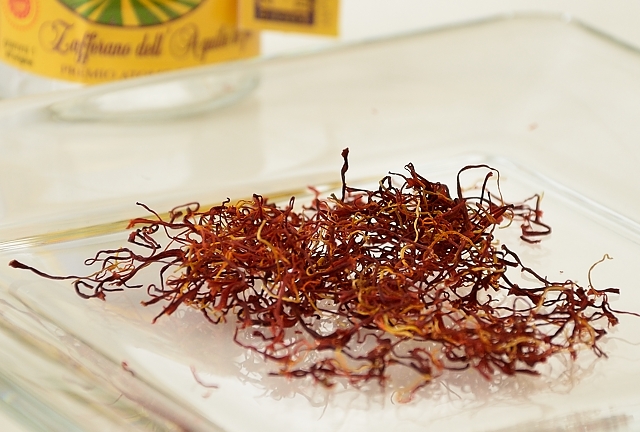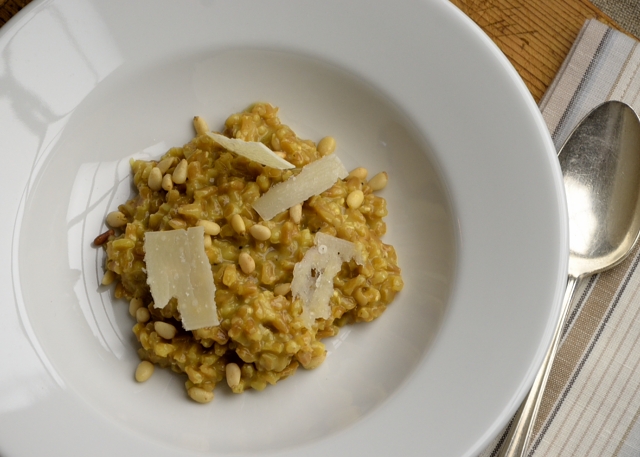Farrotto allo Zafferano con Pignoli Tostati
Creamy Farro with Saffron and Toasted Pine Nuts
I recently received an absolute treasure trove of Rustichella d’Abruzzo products from Rolando Beramendi of Manicaretti Italian Food Importers. Rustichella D’Abruzzo products, the ones that come in the brown bags, have been a favorite of mine since I was first introduced to them in the mid-eighties by food writer Kristine Kidd. I decided to start with the farro (FAHR-oh).

For those of you new to the heirloom grain game, farro is an unhybridized wheat that has been around since man first cultivated cereal back in the Neolithic age. It is not barley. It is not spelt. It is, to be specific, Triticum dicoccum. The kernels can be served whole in salads, side dishes, soups, stews or stuffings. Interest in farro has been building since the nineties, and today it is all the rage in the food world, representing as it does, a return to the old ways of farming and the resurgence of traditional foods.

Whole kernel farro is available in processed and unprocessed form. Unprocessed farro, even with a pre-soak, can take up to an hour to cook. The grains are often refined through a polishing process known as pearling. Farro thus processed is described as either perlato or semi-perlato, referring to just how much of the hard outer husk and bran have been removed during processing, with semi-perlato retaining more of the fiber and nutrient content. The upside of the refining process is much quicker cooking times, anywhere from 20 to 35 minutes. Always read the package directions to check on the cooking time and see if a pre-soak is called for. Semi-perlato farro cooks up best with a brief pre-soak, and retains more of its toothsome bite than farro perlato.

Farro holds up well after cooking, with grains that remain separate, resist getting gummy, and retain their texture over several days. Think of recipes that call for rice (white, brown or otherwise), barley, or bulgur, and chances are that farro will make a happy marriage. Its satisfying bite and chewy texture make it a particularly good match for nuts and dried fruits. Farro is so versatile that it can even be used in sweet dishes, and the proof is in food writer Domenica Marchetti’s Baked Farro Pudding. Slow food, sweet and perfect for a cold morning.
You can also purchase farro flour and make your own farro pasta or use it in breads and other baked goods. Farro puls is a coarser grind that can be used to make porridges and puddings and is delicious when prepared like polenta. Cook it up and layer it with a meat ragù or, my favorite, a mushroom ragù (coming soon to my site.)
Gianluigi Peduzzi of Rustichella d’Abruzzo works with local farmers in the comune of Penne in the Abruzzese province of Pescara to grow over 100 tons of a local variety of farro known as farro vestino (the Vestini were early inhabitants of the area.) The grain is harvested in late spring, and like another Abruzzese favorite, cicerchie, thrives in poor, rocky soil. Rustichella d’Abruzzo sells a semi-pearled version they call “Whole Farro” that is available online from Market Hall Foods.
I decided to use the farro to make a farrotto – a dish cooked in the style of risotto. This cooking method yields perfectly cooked grains of farro enrobed in a creamy, rich sauce. It is a delight on its own or as an accompaniment to a sumptuous beef roast or a Thanksgiving turkey.

Zafferano (saffron), another of Abruzzo’s culinary treasures, adds a hauntingly subtle backdrop of flavor to the dish. The spice is cultivated on the Navelli plain where the dark soil and frigid nights make for perfect growing conditions. It is harvested in October, just as the farro is being planted in neighboring Pescara. Shaved Parmigiano adds a salty bite and pleasing garnish to the farrotto. A vegetable peeler drawn against the side of a piece of Parmigiano makes quick work of forming the shavings. And finally, with a unique flavor and soft chew that yields more willingly to the bite than farro, the toasted pignoli (pine nuts) are a wonderful counterpoint to the grain.
Farrotto allo Zafferano con Pignoli Tostati
Serves 4
This very rich dish is best made with an unsalted, light homemade brodo. If you opt for a commercially prepared brodo, purchase one marked “unsalted” or “low-sodium”, or try Stock Options, an excellent frozen product. If you find that your brodo is very heavily flavored, I suggest substituting 2 cups of water for an equal volume of brodo, otherwise you risk creating a dish that is overpoweringly rich. Take the time to mince the shallots very finely so that they melt into the farrotto, and sauté them gently. If browned or scorched, they will impart an unpleasant and bitter taste to the farrotto. The same goes for the pignoli. Toast them carefully as they too can develop a bitterness that has no place in this elegantly flavored farrotto.
1½ cups farro Rustichella d’Abruzzo Whole Farro
⅓ cup pignoli
6 cups brodo di pollo (click for the recipe)
Very generous pinch, about ¼ teaspoon, zafferano threads
2 tablespoons extra virgin olive oil
¼ cup finely minced shallots
½ cup dry white wine
1-2 tablespoons unsalted butter, softened
¼ cup grated Parmigiano-Reggiano, OR Grana Padano, plus more to shave over farrotto
Fine sea salt
Black pepper
Soak the whole farro in cold water to cover, about 20 minutes. While the farro is soaking, adjust the oven rack to the middle and preheat the oven to 325 degrees F. Place the pignoli on a small rimmed baking sheet and toast on the middle rack until light golden, about 8 minutes, stirring twice. Watch the pignoli closely to avoid scorching. Remove the pignoli from the oven and set aside.
Pour the brodo into a large saucepan. Bring it to a very gentle simmer, and hold it there. While the brodo heats, place the zafferano in a large metal utility spoon, and hold it over an open flame to toast. Once it has begun to release its fragrance, remove it from the flame, transfer it to the bowl of a mortar. Grind it well, and set aside.
Pour the olive oil into a 4-quart, heavy-bottom Dutch oven, and heat over a medium flame. Add the shallots and ¼ teaspoon of fine sea salt. Sauté the shallots, stirring occasionally, until they are translucent and very soft, being careful that they do not color at all. Increase the heat to medium-high, and add the farro all at once, tossing to coat. Toast lightly, stirring occasionally, about 2 minutes. Pour some of the wine into the mortar. Stir, and pour the zafferano-tinted wine into the Dutch oven. Add the remaining wine, using some to completely rinse the zafferano from the mortar. Combine well, and cook, stirring frequently, until the wine has reduced almost completely.
Add enough hot brodo to the pan to just cover the farro. Adjust the heat to maintain a simmer. Cook, stirring attentively until the brodo is almost completely absorbed, and a wooden or silicone spatula leaves a broad, dry path as it is pulled across the bottom of the pot. Continue adding more brodo, a ladleful at a time, to cover, and repeat this process until all the brodo has been added and the mixture has taken on a creamy, risotto-like appearance. Remove the pot from the heat, and add the softened butter, grated cheese, and several grinds of black pepper, stirring briskly to combine. Taste for seasoning, adding more fine sea salt and pepper, if desired.
Spoon into serving bowls, sprinkle with toasted pignoli and top with shaved cheese.
Adapted from The Southern Italian Farmer’s Table by Matthew Scialabba and Melissa Pellegrino
Note: You can click on any picture for a slide show!
Disclosure: I received the product mentioned above for free. I only recommend products or services I use personally and believe will be good for my readers. I otherwise have no affiliation with any product, manufacturer, or site mentioned in this article.



Sunday, November 23rd 2014 at 3:20 pm |
Oh my, this just looks so creamy and luscious and nourishing. 🙂
Sunday, November 23rd 2014 at 8:59 pm |
Hi Krista,
It is all three! I hope you try it. This is delicious!
Sunday, November 23rd 2014 at 3:33 pm |
This is one of the few recipes I’ve seen for farro. I found a bag of quick cooking farro at our local grocer and have been hooked ever since. Lovely recipe!
Sunday, November 23rd 2014 at 9:01 pm |
Hi Kristi,
I really enjoy farro. From cold salads in the summer to soups, stuffings, and hearty vegetarian stews in the winter, this versatile grain is so satisfying. Thank you for stopping by and for taking a moment to comment.
Monday, November 24th 2014 at 1:40 am |
Hi Adri — Yet another gorgeous post. I actually had never tasted farro in my life until I came to Italy. It is the perfect fall food and you have provided what looks like a fabulous recipe. But as always, I appreciate your posts for so many other things — the writing — saffron that creates a “haunting subtle backdrop of flavor”, the details the farro “perlato” or “semi-perlato”, the history — who would have ever guessed farro goes back to the Neolithic age, and the photos — your spidery saffron and pearly farro kernels are lovely.
It is always such a pleasure to read your posts. Un abbraccio, Trisha
Monday, November 24th 2014 at 5:57 am |
Ciao Trisha,
Well if my article is half as nicely written as your comment, I am home free. Thank you for the kind words, and I hope that you try this one. Happy Thanksgiving to you!
Monday, November 24th 2014 at 9:58 pm |
I love the chew of farrow and your dish looks so creamy. I love dishes flavored with saffron, so along with the parmigiano, it looks like have hit all the food groups. Nice work.
Tuesday, November 25th 2014 at 6:04 am |
Hi Lynne,
You are so right. This one has it covered. Thank you for stopping by, and Happy Thanksgiving to you!
Tuesday, November 25th 2014 at 5:42 pm |
I’ve had such a hard time trying to find farro but I have been wanting to use it for so long. This recipe looks amazing, I need to try and figure out where to get it from!
Wednesday, November 26th 2014 at 5:39 am |
Hi Jess,
I do not know where Market Hall Foods ships, but you might ask them if they will ship to you. If you have an Italian store nearby, ask them if they can stock it. It is such a delight. I hope you have an opportunity to taste some soon. Alla prossima!
Tuesday, November 25th 2014 at 7:45 pm |
That’s my favorite way to cook farro, too — risotto-style. I often top a bowl of it with roasted shrimp or a quick saute of mushrooms and peppers.
Wednesday, November 26th 2014 at 5:41 am |
Hi Carloyn,
I am so glad you are a farrotto fan also. Your two versions sound great, especially the mushrooms and peppers. The earthy flavors of both the farro and fungi are a match made in culinary heaven. Happy Thanksgiving to you and yours!
Wednesday, November 26th 2014 at 3:49 pm |
Hi Adri, Great post! Wanted to let you know that I am a big fan of farro. Last year we replaced our risotto stuffing for Thanksgiving with farrotto and everyone loved it. I will add the saffron to it this year. Once almost cooked I mix in wild mushrooms that I saute separately with olive oil, garlic and parsley and then I add more vegetables like sauteed fennel, carrots, celery and whatever else I have. This will be our side stuffing (I don’t stuff the turkey, we are doing a rotisserie turkey this year). Happy Thanksgiving!
Wednesday, November 26th 2014 at 3:54 pm |
Hi Rosetta,
Thank you! Now doesn’t a farrotto stuffing with mushrooms sound divine. We always use wild rice for stuffing, and as I was eating the farro it dawned on me how similar the texture of the two are. You have inspired me to try a farrotto stuffing. I love that you are doing a rotisserie turkey. I hope you write about it. I bet it will be great. Bart will be most envious. Happy Thanksgiving to you and yours.
Wednesday, November 26th 2014 at 9:10 pm |
oh wow! soo good! I\’m in NY (finally) so tomorrow\’s gonna be a big day !
Happy Thanksgiving!
Thursday, November 27th 2014 at 8:50 am |
Hi Marcela,
Benvenuta a New York! I hope you have a wonderful time. Happy Thanksgiving to you!
Friday, November 28th 2014 at 10:15 pm |
Farro really is the most delicious grain that is so very useful for lots of dishes. Lucky you getting try out all of those Rustichella d’Abruzzo pasta products
Monday, December 1st 2014 at 6:53 pm |
Hi Tania,
I love farro. It is so satisfying. And yes, I am lucky indeed. The Rustichella line has always been a favorite of mine. Thanks for stopping by!
Saturday, November 29th 2014 at 12:22 pm |
Cara Adri, farro is indeed delicious and so good for you – I could not agree with you more, it holds its shape splendidly when cooked – beautiful recipe with fabulous ingredients – my kind of food.
Hope you and your family spent a wonderful and happy Thanksgiving!
All the best,
Andrea
Saturday, November 29th 2014 at 2:04 pm |
Hi Andrea,
I am so glad you enjoy farro. It is so satisfying, and I bet you work miracles with it. We had delightful Thanksgiving. Best wishes for a wonderful holiday season to you and yours!
Sunday, November 30th 2014 at 11:35 pm |
Beautiful recipe! I live in Abruzzo and make a similar farrotto. It is great on cold winter days! Instead of Parmigiano, though, I use local pecorino stagionato, to make sure that all igredients are authentic Abruzzese!
Monday, December 1st 2014 at 7:55 am |
Hi Anna,
How fortunate you are to live in Abruzzo. You are so right – with the pecorino you would have “the real deal.” I bet it is delicious with the local cheese. Thank you so much for stopping by!
Wednesday, December 3rd 2014 at 12:01 am |
Bellissimo e buonissimo questo piatto…complimenti! 🙂
Ila
Wednesday, December 3rd 2014 at 6:08 am |
Benvenuta!
Grazie, Ilaria!